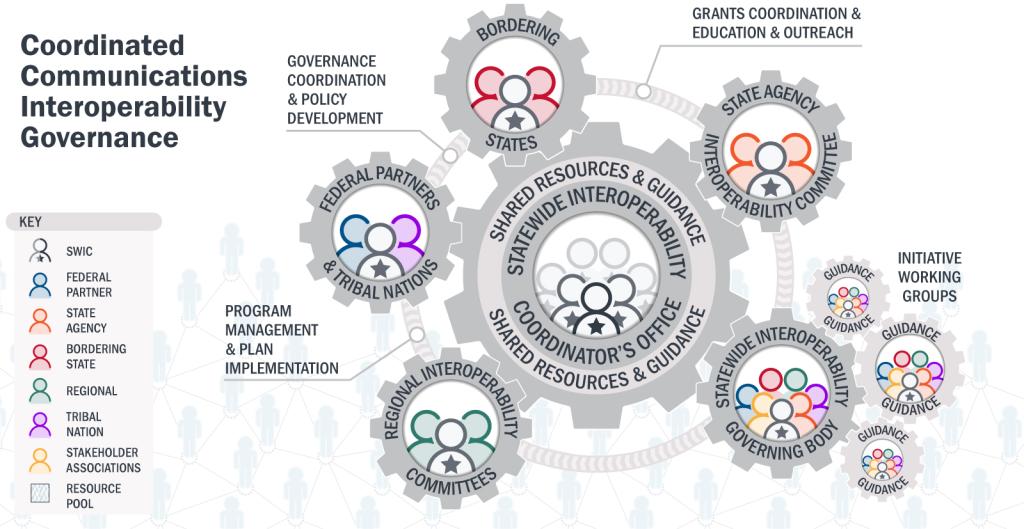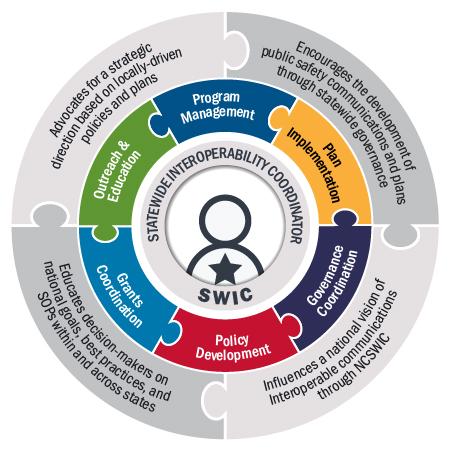Statewide Interoperability Coordinators (SWICs) Roles and Responsibilities

State-Level Role
- Plan and implement the statewide interoperability program, guided by initiatives outlined in the National Emergency Communications Plan (NECP) and Statewide Communications Interoperability Plan (SCIP)
- Collaborate with state, local, tribal, territorial, and federal governments and emergency response groups in long-term strategic planning
- Communicate regularly with all interoperability stakeholders and partners to ensure transparency and information sharing
- Coordinate governing body activities to maximize integration and collaboration across the emergency communications landscape
- Coordinate interstate, intrastate, and regional public safety communications interoperability
National Level Role
- Serve as members of the National Council of Statewide Interoperability Coordinators (NCSWIC), a national governance body established to assist interoperability coordinators with promoting the critical importance of interoperable communications and best practices within their states and nationally[1]
- Serve as the point of contact for the federal government and industry on issues concerning statewide interoperable communications
- Help to ensure federal funding for emergency communications initiatives are coordinated, align to the SCIP, and are compatible with surrounding systems
- Share success stories that are instrumental in developing products and strategies to advocate and secure funding for interoperability solutions within their respective states and at the federal level
- Lead participation in annual interoperability markers review
SWIC Key Capabilities
- Governance
- Advise the Governor, legislatures, and other appointed officials on statewide interoperability policy and funding matters on behalf of the public safety community
- Manage the establishment (i.e., ad-hoc, Executive Order, statute) and sustainment of a statewide governing body such as a Statewide Interoperability Governing Body (SIGB) or Statewide Interoperability Executive Committee, to include committees and working groups Serve as an unbiased advocate/coordinator to enhance interoperability across the spectrum of public safety communications
- Serve as an active member or advisor on all communications related governance bodies and work with public safety answering points and emergency managers in the state to ensure coordination, help identify synergies, and bridge communication gaps
- Coordinate closely with statewide governance bodies seeking guidance and recommendations from the joint efforts of governance members, state agencies, and regional entities
- Ensuring voices of all state agencies are heard and recognized
- Review grants/emergency communications projects
- Program Management
- Oversee interoperability and communications projects in the state and provide regular updates to the Governor, legislatures, and other senior government executives
- Manage support for interoperable project implementation
- Oversee program management support, including staffing, contracting, budgeting, technical resources, and other administrative tasks
- Establish state and local needs for federal Technical Assistance and coordinate accordingly with federal partners
- Promote efficiency and better program management of essential statewide, regional, and local systems
- Manage Communications Unit Leader and Communications Technician training program
- Provide input to the U.S. Department of Homeland Security (DHS) to ensure that individual state needs are reflected in federal funding and policy directives
- Policy Development
- Provide direction, guidance, and assistance for public safety communications
- Assist in drafting and reviewing legislation and other Executive level documents pertaining to public safety communications
- Coordinate in planning for and deploying the National Public Safety Broadband Network and related activities
- Coordinate with the Statewide 911 Coordinator, or similar position(s), in planning for and implementing Next Generation 911 initiatives
- Ensure a comprehensive approach to public safety communications and cybersecurity across all mediums of technology
- Operational
- Support operational communications by leading a state’s Emergency Support Function (ESF) 2 role or provides similar support during times of emergency
- Coordinate with ESF-2 planners for disaster planning
- Technology
- Facilitate information-sharing among potential users, promote asset-sharing between entities, and ensure coordination of ongoing initiatives to ensure they complement, and do not contradict, the deployment of new and emerging technologies
- Develop strategic plans for cyber and physical security for emergency communications
- Advocate for standards adoption, including Project 25 and upcoming data standards
- Promoting interoperability of voice and data technologies
- Outreach and Education
- Oversee the maintenance of a database of stakeholders and resources across the state
- Liaise across different levels of government and all disciplines to build partnerships
- Serve as the point of contact to the federal government and industry on statewide interoperable communications issues and in managing the use of federal frequency channels within the state by developing standard operating procedures (SOP)
- Provide state governance entities with outreach and training support for the state’s emergency responders
- Communicate information regularly with stakeholders to ensure transparency
- Attend and actively participate in national interoperability conferences and workshops and serve as a member of organizations such as National Public Safety Telecommunications Council (NPSTC), Association of Public-Safety Communications Officials (APCO), and the National Emergency Number Association (NENA)
- Participate in the NCSWIC and committee(s) of interest
Supporting A Designated SWIC Office in Your State

The SWIC position is best able to serve the state when there is a stable legislative mandate providing funding, authorities, and governance to oversee communications interoperability initiatives. This work is part of a continuous cycle; states and territories are required to adapt to evolving technologies, operational tactics, and changes to the emergency communications landscape.
NCSWIC Membership is comprised of SWICs and their deputy or alternates from the 56 states and territories. To find additional contact information, visit cisa.gov/safecom/ncswic-membership.
Download the printable SWIC Roles and Responsibilities(.pdf, 2.04 MB) handout!
[1]The Cybersecurity and Infrastructure Security Agency (CISA) facilitates various in-person NCSWIC meetings to build partnerships, discuss pressing issues impacting emergency communications interoperability, and share best practices and lessons learned. Additionally, NCSWIC meetings are an opportunity for the Regional Interoperability Councils (RIC), a subcomponent of the NCSWIC, to discuss and address regional interoperability challenges.




